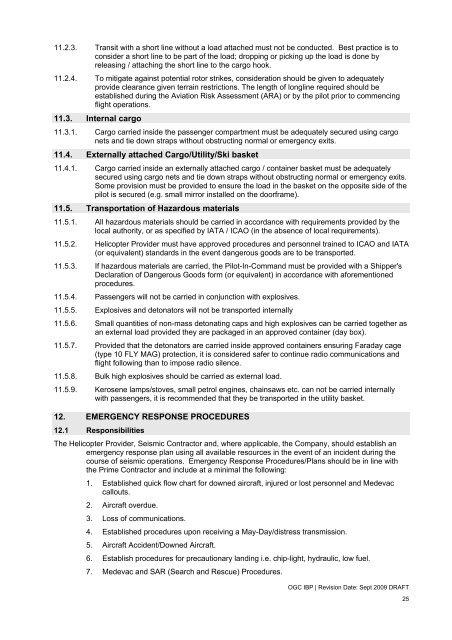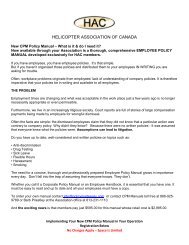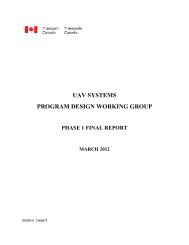HAC Oil & Gas IBP - Helicopter Association of Canada
HAC Oil & Gas IBP - Helicopter Association of Canada
HAC Oil & Gas IBP - Helicopter Association of Canada
You also want an ePaper? Increase the reach of your titles
YUMPU automatically turns print PDFs into web optimized ePapers that Google loves.
11.2.3. Transit with a short line without a load attached must not be conducted. Best practice is toconsider a short line to be part <strong>of</strong> the load; dropping or picking up the load is done byreleasing / attaching the short line to the cargo hook.11.2.4. To mitigate against potential rotor strikes, consideration should be given to adequatelyprovide clearance given terrain restrictions. The length <strong>of</strong> longline required should beestablished during the Aviation Risk Assessment (ARA) or by the pilot prior to commencingflight operations.11.3. Internal cargo11.3.1. Cargo carried inside the passenger compartment must be adequately secured using cargonets and tie down straps without obstructing normal or emergency exits.11.4. Externally attached Cargo/Utility/Ski basket11.4.1. Cargo carried inside an externally attached cargo / container basket must be adequatelysecured using cargo nets and tie down straps without obstructing normal or emergency exits.Some provision must be provided to ensure the load in the basket on the opposite side <strong>of</strong> thepilot is secured (e.g. small mirror installed on the doorframe).11.5. Transportation <strong>of</strong> Hazardous materials11.5.1. All hazardous materials should be carried in accordance with requirements provided by thelocal authority, or as specified by IATA / ICAO (in the absence <strong>of</strong> local requirements).11.5.2. <strong>Helicopter</strong> Provider must have approved procedures and personnel trained to ICAO and IATA(or equivalent) standards in the event dangerous goods are to be transported.11.5.3. If hazardous materials are carried, the Pilot-In-Command must be provided with a Shipper'sDeclaration <strong>of</strong> Dangerous Goods form (or equivalent) in accordance with aforementionedprocedures.11.5.4. Passengers will not be carried in conjunction with explosives.11.5.5. Explosives and detonators will not be transported internally11.5.6. Small quantities <strong>of</strong> non-mass detonating caps and high explosives can be carried together asan external load provided they are packaged in an approved container (day box).11.5.7. Provided that the detonators are carried inside approved containers ensuring Faraday cage(type 10 FLY MAG) protection, it is considered safer to continue radio communications andflight following than to impose radio silence.11.5.8. Bulk high explosives should be carried as external load.11.5.9. Kerosene lamps/stoves, small petrol engines, chainsaws etc. can not be carried internallywith passengers, it is recommended that they be transported in the utility basket.12. EMERGENCY RESPONSE PROCEDURES12.1 ResponsibilitiesThe <strong>Helicopter</strong> Provider, Seismic Contractor and, where applicable, the Company, should establish anemergency response plan using all available resources in the event <strong>of</strong> an incident during thecourse <strong>of</strong> seismic operations. Emergency Response Procedures/Plans should be in line withthe Prime Contractor and include at a minimal the following:1. Established quick flow chart for downed aircraft, injured or lost personnel and Medevaccallouts.2. Aircraft overdue.3. Loss <strong>of</strong> communications.4. Established procedures upon receiving a May-Day/distress transmission.5. Aircraft Accident/Downed Aircraft.6. Establish procedures for precautionary landing i.e. chip-light, hydraulic, low fuel.7. Medevac and SAR (Search and Rescue) Procedures.OGC <strong>IBP</strong> | Revision Date: Sept 2009 DRAFT25









